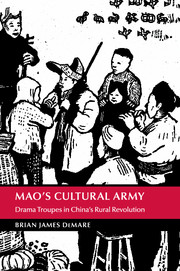Book contents
- Mao's Cultural Army
- Cambridge Studies in the History of the People's Republic of China
- Mao's Cultural Army
- Copyright page
- Contents
- Illustrations
- Preface and acknowledgements
- Glossary
- Introduction
- 1 The revolution will be dramatized
- 2 Acting against Japan
- 3 Playing soldiers and peasants
- 4 Staging rural revolution
- 5 State agents and local actors
- 6 Peasants on stage
- 7 Tradition in conflict
- Conclusion
- Select bibliography
- Index
- References
Select bibliography
Published online by Cambridge University Press: 05 April 2015
- Mao's Cultural Army
- Cambridge Studies in the History of the People's Republic of China
- Mao's Cultural Army
- Copyright page
- Contents
- Illustrations
- Preface and acknowledgements
- Glossary
- Introduction
- 1 The revolution will be dramatized
- 2 Acting against Japan
- 3 Playing soldiers and peasants
- 4 Staging rural revolution
- 5 State agents and local actors
- 6 Peasants on stage
- 7 Tradition in conflict
- Conclusion
- Select bibliography
- Index
- References
- Type
- Chapter
- Information
- Mao's Cultural ArmyDrama Troupes in China's Rural Revolution, pp. 243 - 248Publisher: Cambridge University PressPrint publication year: 2015



